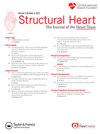基于基线三尖瓣返流的二尖瓣边缘修复术后的生活质量
IF 2.8
Q3 CARDIAC & CARDIOVASCULAR SYSTEMS
引用次数: 0
摘要
背景:在接受二尖瓣经导管边缘到边缘修复(M-TEER)的患者中,明显的三尖瓣反流(TR)的发生率很高。显著TR与预后不良相关,并影响M-TEER与合并二尖瓣和三尖瓣手术的决策。生活质量(QoL)的改善是衡量患者生活质量的重要指标。方法:我们分析了2015年至2023年多中心全州登记的1838例M-TEER患者的数据。使用基线和30天堪萨斯城心肌病问卷(KCCQ)评分评估生活质量。将患者分为无/轻度TR和中度/重度TR,比较KCCQ评分的变化。主要结局是一个调整后的分析,包括生存至30天,KCCQ评分改善≥15分。结果1421例(77.3%)患者获得完整的终点数据。平均而言,无论基线TR组如何,接受M-TEER的患者的生活质量都有很大改善。中度/重度TR患者的30天死亡率高于无/轻度TR患者(分别为42[4.1%]对16 [2.0%],p = 0.018)。大多数患者存活至30天,ΔKCCQ≥15(无/轻度TR为63.8%,中度/重度TR为59.6%,p = 0.120)。中度/重度TR患者的主要调整结果无差异(调整优势比:0.851,p = 0.177)。结论:无论基线TR严重程度如何,大多数患者在M-TEER后的生活质量都有很大改善。进一步的研究应该探索分阶段的M-TEER方法,然后根据需要进行三尖瓣干预,而不是同时进行二尖瓣/三尖瓣手术。本文章由计算机程序翻译,如有差异,请以英文原文为准。

Quality of Life After Mitral Transcatheter Edge-to-Edge Repair According to Baseline Tricuspid Regurgitation
Background
There is a high prevalence of significant tricuspid regurgitation (TR) in patients undergoing mitral transcatheter edge-to-edge repair (M-TEER). Significant TR is associated with poor prognosis and affects decision-making between M-TEER and concomitant mitral and tricuspid valve surgery. Improved quality of life (QoL) is an important metric for patients.
Methods
We analyzed data from 1838 patients undergoing M-TEER included in a multicenter statewide registry from 2015 to 2023. QoL was assessed using baseline and 30-day Kansas City Cardiomyopathy Questionnaire (KCCQ) scores. Patients were classified as no/mild TR or moderate/severe TR, and changes in KCCQ scores were compared. The primary outcome was an adjusted analysis consisting of survival to 30 days with a ≥15-point improvement in KCCQ score.
Results
Complete endpoint data were available for 1421 patients (77.3%). On average, patients undergoing M-TEER experienced large improvements in QoL, regardless of baseline TR group. Thirty-day mortality for patients with moderate/severe TR was higher than for those with no/mild TR (42 [4.1%] vs. 16 [2.0%], respectively, p = 0.018). The majority of patients survived to 30 days with ΔKCCQ ≥15 (63.8% for no/mild TR vs. 59.6% for moderate/severe TR, p = 0.120). Patients with moderate/severe TR exhibited no difference in the primary adjusted outcome (adjusted odds ratio: 0.851, p = 0.177).
Conclusions
The majority of patients experience a large improvement in QoL after M-TEER, regardless of baseline TR severity. Further research should explore a staged approach of M-TEER followed by tricuspid valve intervention as needed compared to concomitant mitral/tricuspid valve surgery.
求助全文
通过发布文献求助,成功后即可免费获取论文全文。
去求助
来源期刊

Structural Heart
Medicine-Cardiology and Cardiovascular Medicine
CiteScore
1.60
自引率
0.00%
发文量
81
 求助内容:
求助内容: 应助结果提醒方式:
应助结果提醒方式:


